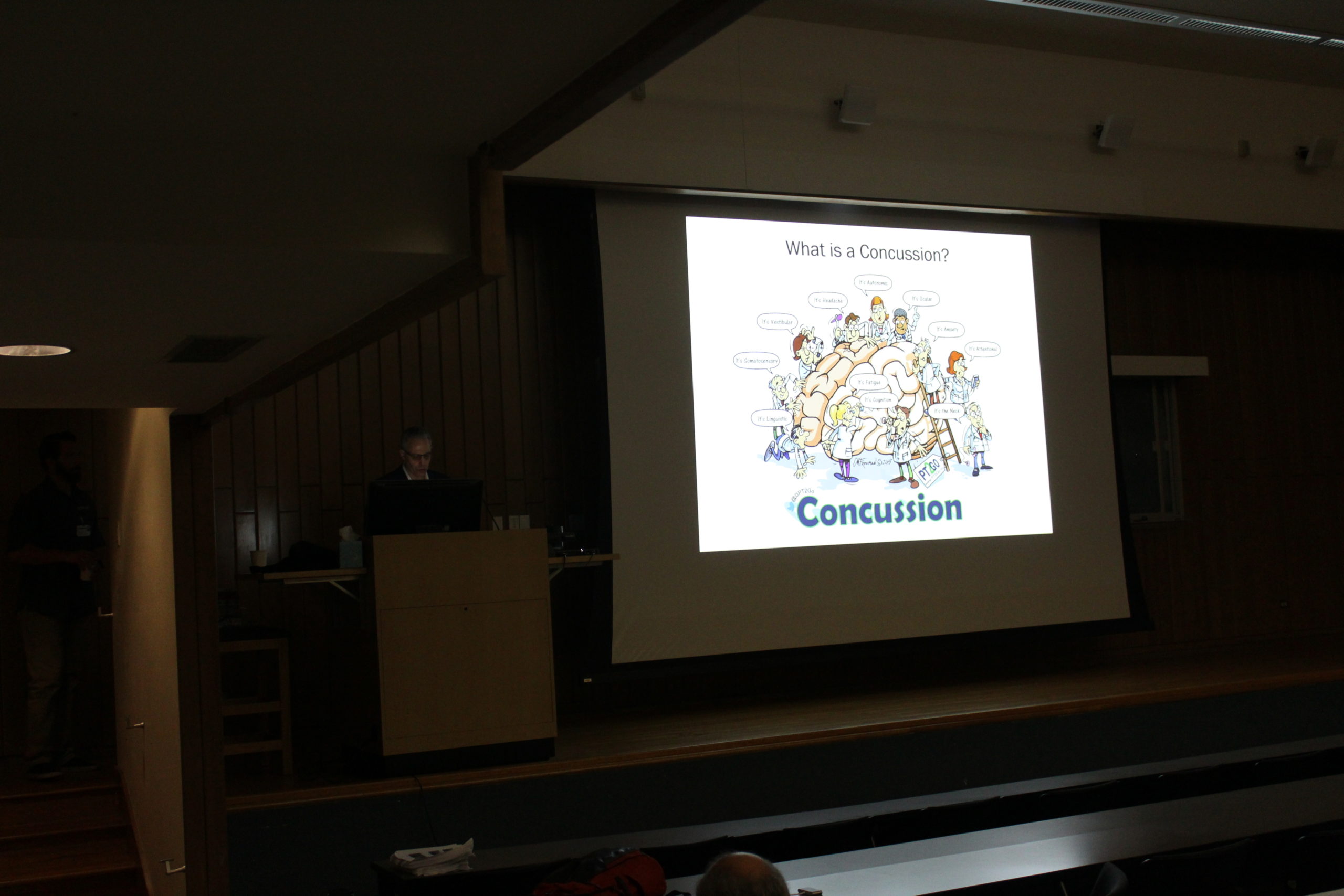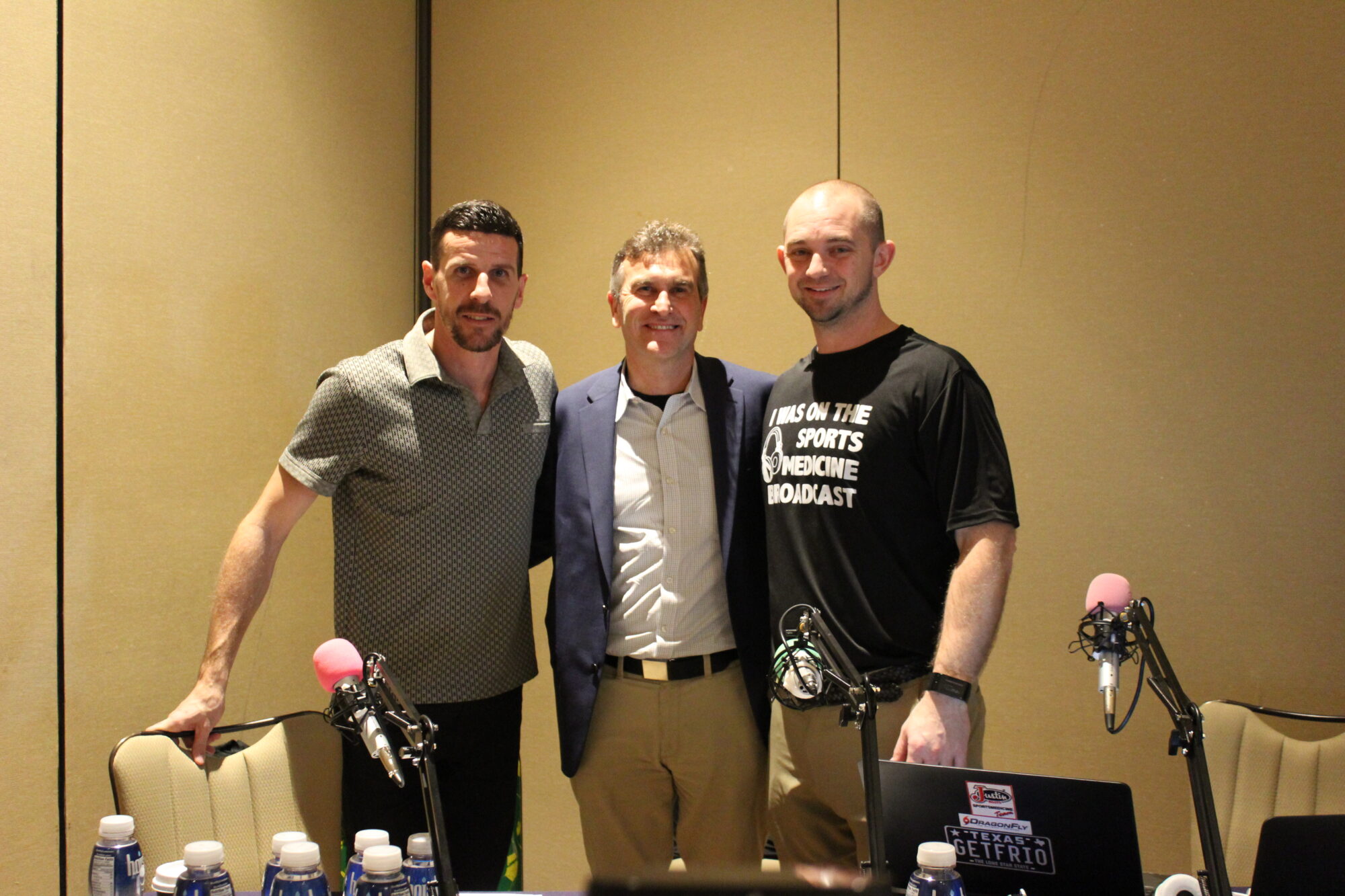Podcast: Play in new window | Download
Dr. Podell says concussions are treatable. I have traditionally heard you do not treat a concussion, instead you manage it.
Join Dr. Podell for a discussion live from the Trinity University Sports medicine Workshop 2020.

Cervical Strain is Treatable – 3 min
Neck issues can play a big role in prolonged headaches.
Location of headaches may correlate to the c-spine that has been affected.
Role of Myodural connection – 5 minutes
“Effect of the Suboccipital Musculature on Symptom Severity and Recovery after Mild Traumatic Brain Injury”: http://www.ajnr.org/content/37/8/1556
Study done in 2016 on myodural bridge and its connection to post-concussive symptoms, may suggest that treating suboccipital musculature early on may reduce post-concussive headaches and/or other symptoms.
Neck strengthening and conditioning – 6-9 min
Neck girth and strength = reduced impact to the head and neck
Strength exercises must be done in all planes!
“The effects of rest and treatment following sport-related concussion: a systematic review of the literature”
https://bjsm.bmj.com/content/47/5/304.long
Studies revealed that those who reported pre-season baseline symptoms had an increased risk for concussions during the season.
“Sex Differences in Head Acceleration During Heading While Wearing Soccer Headgear”
https://www.ncbi.nlm.nih.gov/pmc/articles/PMC2582549/
The study revealed that soccer females wearing headgear had greater head acceleration compared to males who had a slight decrease in head acceleration. This suggests that headgear may not be appropriate for all athletes.
Measuring Neck Strength – 10 min
“Neck Strength: A Protective Factor Reducing Risk for Concussion in High School Sports”
This study showed that “smaller mean neck circumference, smaller mean neck to head circumference ratio, and weaker mean overall neck strength were significantly associated with concussion.”
Vestibular balance is also treatable – 15 min
BESS/ Sway app / Force plate
Balance work = decreased risk of lower body injuries relating to prior concussions
Vestibular-ocular – 17 minutes
“Does it feel unstable to you?” “Rocky boat”
Are they experiencing vertigo?
Increased s/s if they were previously experiencing motion sickness
Vestibular-ocular issues are a “major source of fatigue, headaches, and cognitive problems
Vestibular Ocular Motor Screen (VOMS);
smooth pursuits, horizontal and vertical saccades, horizontal vestibulo-ocular reflex, near point convergence, visual motion sensitivity
Home exercises; Eply/Brandt-Daroff exercises and gaze stabilization
Beginning vestibular therapy at two weeks will greatly impact and help during post concussion recovery
Training for professionals in vestibular rehab techniques is available
CAUTION!
v-o issues may cause difficulties while driving, showering, and going downstairs
Ocular-Motor exercises 24-28 min
Newer technology;
SyncThink, RightEye, and Oculogica (FDA approved)
Home program “Eyecanlearn” (http://www.eyecanlearn.com/).
Cognitive – 29min
Baseline assessments can be viewed as more of a luxury than a necessity.
Computerized testing;
Impact, C3 Logix, and CNS Vital Signs
Important qualities needed;
“Appropriate psychometric properties, interpretation by a qualified professional, and an appropriate environment and motivation are key factors.”
They can be more useful in RTP clearance than as a diagnostic tool.
Symptom Reporting – 31 minutes
Post-Concussion Symptom Scale can be helpful in individualizing treatment and rehab.
Psychological / Emotional – 33
Some individuals experience;
Increased anxiety levels and withdrawal (missing school, work, sport)
Depression and Poor sleep (may cause an increase in s/s)
Autonomic Dysfunction – 34 min
Damage of the long fibers that connect the brain stem and midbrain to the cortex which cause dysfunction in communication.
This is an imbalance of the sympathetic and parasympathetic nervous systems.
Signs and symptoms of Dysautonomia:
- Orthostatic hypotension
- Diaphoresis
- Blurred/double vision
- Photophobia
- Bowel problems
- Exercise intolerance
- Feeling winded
- Insomnia
- Dizziness
- HR (tachycardia/bradycardia)
- Tunnel vision
- Weakness
- Vertigo
- Brain fog
Many cardio-vascular responses in concussive patients are altered.
Assessment – 38 minutes
Ways to assess autonomic dysfunction; orthostatic BP/HR (lying and standing), exercise intolerance, Valsalva maneuver (baroreceptor functioning), HRV, head-up tilt table.
Buffalo Concussion Treadmill Test (BCTT), assesses “physiologic measures of ANS to help differentiate if post-concussive symptoms are physiologically based.”
Take away – 42min
After about 48hrs you can begin manual treatment of the head and neck.
After about 72hrs, if the symptom checklist has decreased, you may begin a controlled exercise program.
Begin treatment in the EARLY recovery phase.
Incorporate neck strengthening as a concussion prevention tool.
A concussion is a multi-system and functional injury that requires comprehensive evaluations.
Watch the video recording of Concussions Are Treatable
Be sure to get your free CEUs for other shows podcasts sponsored by the same group hosting the live event this was recorded at.
Complete the course work to earn Category A CEUs sponsored by Methodist Healthcare Sports Medicine of San Antonio – SportsMedicineBroadcast.com/CEU
Help the show keep growing by visiting the sponors:
Frio Hydration – Superior Hydration products.
Donate and get some swag (like Patreon but for the school)
HOIST – No matter your reason for dehydration DRINK HOIST
MedBridge Education – Use “TheSMB” to save some, be entered in a drawing for a second year free, and support the podcast.
Marc Pro – Use “THESMB” to recover better.

